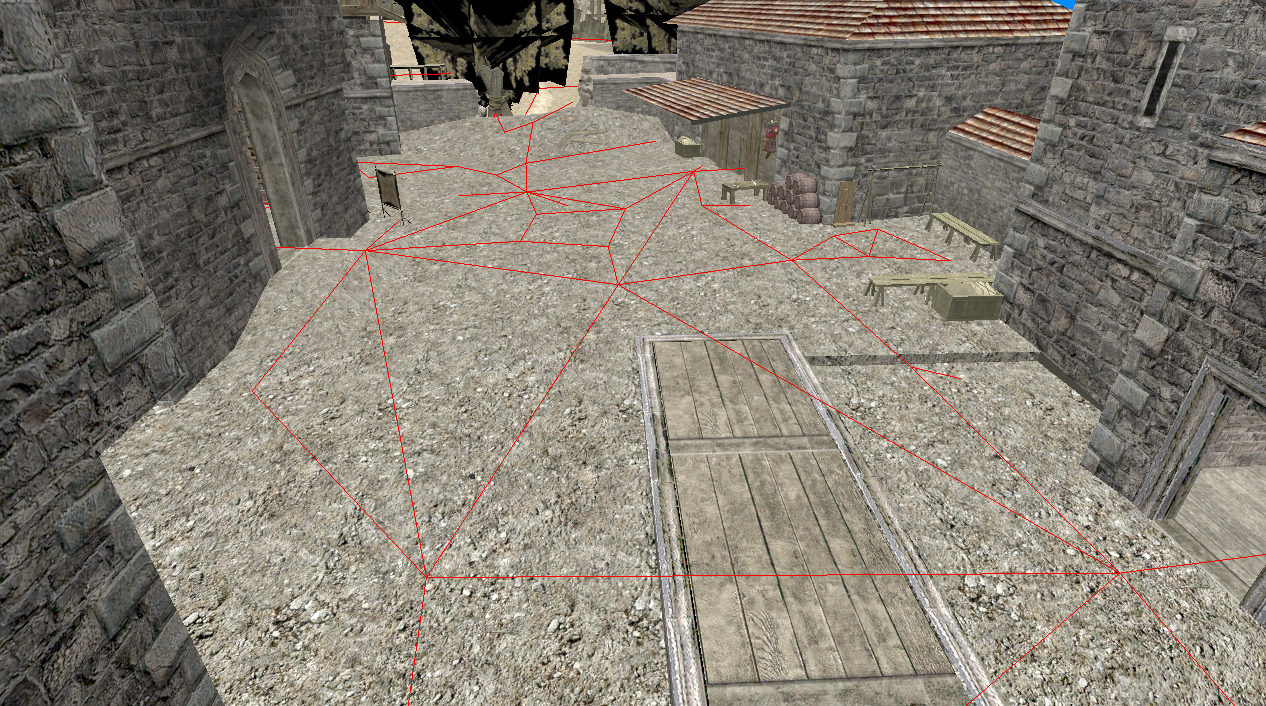Waynet¶
This chapter will discuss what the waynet is, what it is used for and how to access it in REGoth.
Most of waynet-related operations can be found inside the components Waynet and Waypoint
defined in:
src/components/Waynet.hppandsrc/components/Waypoint.hpp, respectively.
What is the Waynet?¶
The Waynet’s main use case is to allow AI controlled characters to navigate through the world. It tells the AI which paths can be taken to reach a certain destination. Think of it like a street-map for the AI. See Fig. 1 for an example.

Fig. 1 Waynet of the Old-Camp in Gothic 2 visualized. The places at the intersections are called Waypoints. A line from one Waypoint to another means that there is a path between them the AI can take.
This street-map is built up from Waypoints and Paths. Waypoints are normal Scene-Objects with
the Waypoint-component attached. This component stores references to all other Waypoints that
can be reached directly from its location. If a Waypoint is in reach of another Waypoint, that
means there is a Path between the two.
The scripts actually only tell the target destination a character should go to, so some sort of algorithm to find the shortest path to it is needed.
The Waynet-Components¶
Once a world has been loaded (See World), the worlds Waynet can be queried by
REGoth::gWorld().waynet(). This will return a handle of a Waynet-Component.
This Waynet-component offers a list of all known Waypoints and functions to search for specific
ones. Since every Waypoint is a normal Scene-Object, you can also simply do a recursive search for
the name you are looking for from the scenes root object.
Note
If you are querying a Waypoint by name and you are not completely sure that the object you are looking for is indeed a Waypoint, it’s better to search the full scene.
If you have a Waypoint-component at hand, you can query the paths reachable from that Waypoint
from it.
TODO: Pathfinding should also be implemented in the waynet, or at least accessible from it.
How Pathfinding works¶
Pathfinding describes the process of finding the shortest path between two locations. Those two locations do not need to be directly on the waynet, but a Waypoint should be in reach for the start and end locations.
A naive solution would be to simply use a shortest-path algorithm like Dijkstras-Algorithm to find the sequence of Waypoints that would get the AI to its destination.
It turns out that this is not the full story. In Gothic, AI controlled characters will often not use the shortest possible path, but go an other route. How that is determined is unknown.
For example: When using the shortest path possible, the character showing the way from the old camp to the swamp will go though the forest, while he goes around the forest in the original.
Note
Since the Waynet is supposed to be static, it might be beneficial to precompute the distances between Waypoints and store them in an acceleration structure for faster pathfinding.
TODO: Need more information.